Derepression of the Her-2 uORF is mediated by a novel post-transcriptional control mechanism in cancer cells - PubMed
- ️Sun Jan 01 2006
Derepression of the Her-2 uORF is mediated by a novel post-transcriptional control mechanism in cancer cells
Anuradha Mehta et al. Genes Dev. 2006.
Abstract
Transcripts harboring 5' upstream open reading frames (uORFs) are often found in genes controlling cell growth including receptors, oncogenes, or growth factors. uORFs can modulate translation or RNA stability and mediate inefficient translation of these potent proteins under normal conditions. In dysregulated cancer cells, where the gene product, for example Her-2 receptor, is overexpressed, post-transcriptional processes must exist that serve to override the inhibitory effects of the uORFs. The 5' untranslated region (UTR) of Her-2 mRNA contains a short uORF that represses translation of the downstream coding region. We demonstrate that in Her-2 overexpressing breast cancer cells, the 3' UTR of the Her-2 mRNA can override translational inhibition mediated by the Her-2 uORF. Within this 3' UTR, a translational derepression element (TDE) that binds to a 38-kDa protein was identified. These results define a novel biological mechanism in which translational control of genes harboring a 5' uORF can be modulated by elements in their 3' UTRs.
Figures
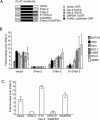
Translational regulation of Luc mRNA by the Her-2 UTRs in a panel of cell lines. (A) Schematic of the firefly luciferase (Fluc) reporter constructs containing various combinations of 5′ and 3′ UTRs. (B) The reporter constructs were expressed via transient transfection in a number of cell lines. The activity was measured 72 h post-transfection and normalized to either Renilla luciferase or to β-galactosidase units. The results were expressed as fold increase over the 5′ UTR-Fluc units. (C) Reporter constructs containing 5′ Her-2 UTR in combination with 3′ UTR from either Her-2 or GAPDH were expressed transiently in SKBR-3 cells. Translational derepression specifically requires Her-2 3′ UTR since the Luc constructs containing GAPDH 3′ UTR do not derepress translational inhibition by the Her-2 5′ UTR in SKBR-3 cells.
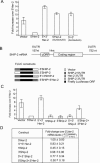
(A) Derepression by the 3′ UTR requires translation of uORF in Her-2 5′ UTR. The constructs containing wild-type and mutated uORF (AUG to AAG) were transfected into SKBR-3 cells and the activity determined as described in Figure 1. Removal of the uAUG results in loss of the 3′-UTR-mediated derepression of translation. (B) Schematic depicting the location of uORF in SHIP-2 mRNA and the Fluc constructs containing chimeric Her-2 and SHIP-2 UTRs. (C) The 3′ Her-2 UTR derepresses heterologous Ship-2 uORF-mediated inhibition of translation of the reporter in SKBR-3 cells. (D) The table shows the relative levels of mRNA of transiently expressed constructs compared with that of 5′ Her-2 mRNA. The RT–PCR data show that the difference in the RNA levels of 5′ + 3′ SHIP-2 and 5′ SHIP-2 + 3′ Her-2 constructs did not contribute significantly to the derepression of SHIP-2 uORF.
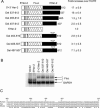
Identification of a U-rich TDE in the 3′ UTR of Her-2 mRNA. (A) The firefly luciferase activity of the constructs containing 3′-end deletions and internal deletions is shown. (B) Northern analysis of the transiently expressed firefly luciferase RNA and the endogenous GAPDH RNA shows stable accumulation of all transcripts 72 h post-transfection. The sequence alignment of the 73-nt U-rich TDE across mammalian species is shown in C.
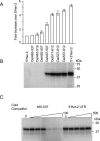
Derepression activity of TDE correlates with the UV-cross-linking of 38-kDa protein. (A) The luciferase activity of the Fluc constructs containing 5′ Her-2 UTR and internal and 3′-end deletions of Her-2 3′ UTR. (B) The 3′ Her-2 UTR UV-cross-linked to a 38-kDa protein from SKBR-3 extracts. Proteins UV-cross-linked to labeled RNA probes were resolved on 10%–14.5% SDS-PAGE as described in Materials and Methods. Molecular size markers are indicated on the right. (C) Competition of the UV-cross-linked band by 73-nt TDE but not by the sequences of the 5′ UTR of Her-2 mRNA. The T7 polymerase-transcribed 32P-labeled 3′ Her-2 UTR RNA was incubated with SKBR-3 cytoplasmic extracts in the absence of competitor (none) or in the presence of a 2.5-fold, fivefold, 20-fold, 50-fold, or 100-fold molar excess of unlabeled 465–537-nt RNA or with a 10-fold, 50-fold, 100-fold, or 500-fold molar excess of the 178-nt 5′ Her-2 UTR RNA.
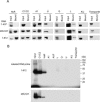
(A) A specific protein complex assembles on the 73-nt TDE. Western blot analysis of the protein complexes formed on biotinylated RNA encoding full-length 3′ UTR (1–612) or the 73-nt (465–537) or on RNA lacking the TDE (1–407). The complexes formed on RNA–streptavidin beads were resolved on SDS-PAGE and immunoblotted to nitrocellulose membrane. The blots were probed with antibodies to various proteins. (B) The UV-cross-linked proteins were immunoprecipitated by anti-HuR and anti-C1/C2 antibodies. The proteins cross-linked to the full-length 3′ UTR (1–612) or to the 73-nt binding site were incubated with various antibodies and the immunoprecipitated complexes resolved by SDS-PAGE and visualized by autoradiography.
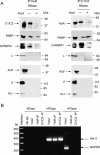
(A) Identification of native complexes assembled in SKBR-3 cells. The SKBR-3 cytoplasmic extracts were left untreated or treated with RNase cocktail on ice for 30 min. The extracts were immunoprecipitated with anti-HuR or anti-C1/C2 antibodies and the complexes immobilized on nitrocellulose. The presence of PABP, AUF, HuR, C1/C2, A1, and other hnRNP proteins was examined by immunodetection with corresponding antibodies. (B) Association of the endogenous Her-2 mRNA with the HuR/C1/C2 complexes in SKBR-3 cells. The RNA–protein complexes in SKBR-3 cells were cross-linked by formaldehyde and the extracts were made as described in Materials and Methods. The extracts were immunoprecipitated with either anti-HuR or anti-C1/C2 antibodies and the RNA–protein cross-links were reversed by heat treatment. The RNA associated with the complexes was extracted with Trizol and used for first-strand cDNA synthesis. The presence of Her-2 RNA or nonspecific GAPDH RNA was detected by PCR using gene-specific primers.
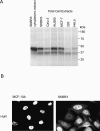
Functional significance of the TDE–protein complex. UV-cross-linking studies were performed using extracts prepared from cell lines that express Her-2 to varying levels. A more intense cross-linked complex was detected in high Her-2 expressers (SKBR3, AU565, Calu3, MCF-7) compared with the low Her-2 expressers (293T, HeLa, HepG2). (B) Immunofluorescence microscopy of HuR in breast cancer cells. More cytoplasmic HuR was detected in SKBR-3 cells, a high Her-2 expresser compared with MCF-10A, a low Her-2 expressing cell line.
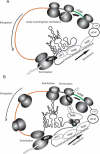
Model for translational derepression by Her-2 3′ UTR. (A) Based on earlier studies, the conceptual closed-loop model shows interactions of PABP with the cap complex at the 5′ end as well as its interaction with eRF3 at the stop codon near the 3′ end of the coding region. In the simplest scenario, the ribosomes translating the uORF remain stalled at the uUGA in cell lines where derepression is not significant. Under these conditions the translation of Her-2 protein is dependent on leaky scanning and/or inefficient reinitiation. (B) In cells overexpressing Her-2 protein, the highly folded 3′ UTR along with the protein complex docked on TDE facilitates rapid termination at the uUGA via the PABP–eRF3 contacts. The 40S ribsome that remains attached retains certain initiation factors, reacquires eIF2-Met-tRNAi-GTP, and is recycled to the main coding region with higher efficiency. The ribosomes terminating at the uUGA support formation of a pretzel-like mRNP structure as described in the Discussion. Such a structure would allow terminating ribosomes to recycle onto the same transcript through interactions with the 3′-UTR protein complex.
Comment in
-
Downstream control of upstream open reading frames.
Sachs MS, Geballe AP. Sachs MS, et al. Genes Dev. 2006 Apr 15;20(8):915-21. doi: 10.1101/gad.1427006. Genes Dev. 2006. PMID: 16618802 No abstract available.
Similar articles
-
Translational control by an upstream open reading frame in the HER-2/neu transcript.
Child SJ, Miller MK, Geballe AP. Child SJ, et al. J Biol Chem. 1999 Aug 20;274(34):24335-41. doi: 10.1074/jbc.274.34.24335. J Biol Chem. 1999. PMID: 10446211
-
Vilela C, Linz B, Rodrigues-Pousada C, McCarthy JE. Vilela C, et al. Nucleic Acids Res. 1998 Mar 1;26(5):1150-9. doi: 10.1093/nar/26.5.1150. Nucleic Acids Res. 1998. PMID: 9469820 Free PMC article.
-
Akimoto C, Sakashita E, Kasashima K, Kuroiwa K, Tominaga K, Hamamoto T, Endo H. Akimoto C, et al. Biochim Biophys Acta. 2013 Mar;1830(3):2728-38. doi: 10.1016/j.bbagen.2012.12.010. Biochim Biophys Acta. 2013. PMID: 23671934
-
Regulation of plant translation by upstream open reading frames.
von Arnim AG, Jia Q, Vaughn JN. von Arnim AG, et al. Plant Sci. 2014 Jan;214:1-12. doi: 10.1016/j.plantsci.2013.09.006. Epub 2013 Sep 18. Plant Sci. 2014. PMID: 24268158 Review.
-
Liang XH, Shen W, Crooke ST. Liang XH, et al. Adv Exp Med Biol. 2017;983:129-146. doi: 10.1007/978-981-10-4310-9_9. Adv Exp Med Biol. 2017. PMID: 28639196 Review.
Cited by
-
Alternative RNA structure-coupled gene regulations in tumorigenesis.
Chen FC. Chen FC. Int J Mol Sci. 2014 Dec 29;16(1):452-75. doi: 10.3390/ijms16010452. Int J Mol Sci. 2014. PMID: 25551597 Free PMC article. Review.
-
The Functional Meaning of 5'UTR in Protein-Coding Genes.
Ryczek N, Łyś A, Makałowska I. Ryczek N, et al. Int J Mol Sci. 2023 Feb 3;24(3):2976. doi: 10.3390/ijms24032976. Int J Mol Sci. 2023. PMID: 36769304 Free PMC article. Review.
-
Tan S, Ding K, Chong QY, Zhao J, Liu Y, Shao Y, Zhang Y, Yu Q, Xiong Z, Zhang W, Zhang M, Li G, Li X, Kong X, Ahmad A, Wu Z, Wu Q, Zhao X, Lobie PE, Zhu T. Tan S, et al. J Biol Chem. 2017 Aug 18;292(33):13551-13564. doi: 10.1074/jbc.M117.780973. Epub 2017 Jun 21. J Biol Chem. 2017. PMID: 28637868 Free PMC article.
-
Gene expression regulation by upstream open reading frames and human disease.
Barbosa C, Peixeiro I, Romão L. Barbosa C, et al. PLoS Genet. 2013;9(8):e1003529. doi: 10.1371/journal.pgen.1003529. Epub 2013 Aug 8. PLoS Genet. 2013. PMID: 23950723 Free PMC article. Review.
-
Tiny but mighty: Diverse functions of uORFs that regulate gene expression.
Zhong Z, Li Y, Sun Q, Chen D. Zhong Z, et al. Comput Struct Biotechnol J. 2024 Oct 28;23:3771-3779. doi: 10.1016/j.csbj.2024.10.042. eCollection 2024 Dec. Comput Struct Biotechnol J. 2024. PMID: 39525088 Free PMC article. Review.
References
-
- Bae C.D., Juhnn Y.S., Park J.B. Post-transcriptional control of c-erb B-2 overexpression in stomach cancer cells. Exp. Mol. Med. 2001;33:15–19. - PubMed
-
- Child S.J., Miller M.K., Geballe A.P. Cell type-dependent and -independent control of HER-2/neu translation. Int. J. Biochem. Cell Biol. 1999a;31:201–213. - PubMed
-
- Child S.J., Miller M.K., Geballe A.P. Translational control by an upstream open reading frame in the HER-2/neu transcript. J. Biol. Chem. 1999b;274:24335–24341. - PubMed
MeSH terms
Substances
LinkOut - more resources
Full Text Sources
Other Literature Sources
Research Materials
Miscellaneous